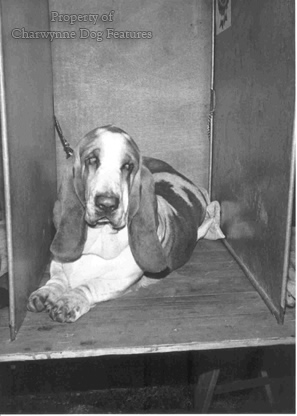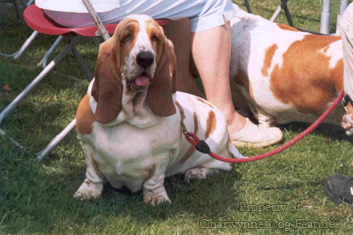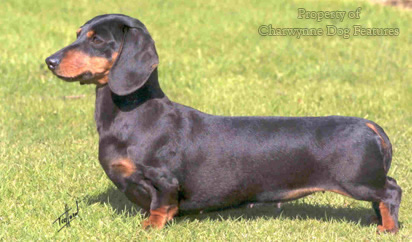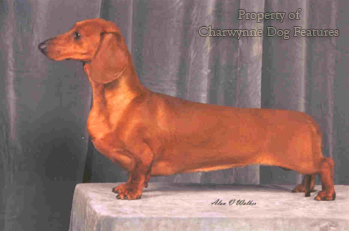155 Setting Better Breed Standards
SETTING STANDARDS
by David Hancock
 The judging of livestock, mainly by eye, is always going to have a strongly subjective element for we are all individuals with conscious bias and subconscious preferences. Being involved in the breeding and showing of pedigree farm animals I find comparatively a greater number of stumbling blocks in the judging of dogs at conformation shows. I am aware too, of more knowledgeable judges on the flags at houndshows and better trained judges on the continent. I also sometimes come across widely differing interpretations of the written description of what is desired in pedigree breeds of dog between judges, a breed club and a number of the breeders. Far too many breed standards are not exactly masterpieces of the written word, some are open to misunderstandings, a few to abuse. And if words are not used accurately, to convey clear guidance to both breeder and judge, then it is possible for a standard to do more harm than good.
The judging of livestock, mainly by eye, is always going to have a strongly subjective element for we are all individuals with conscious bias and subconscious preferences. Being involved in the breeding and showing of pedigree farm animals I find comparatively a greater number of stumbling blocks in the judging of dogs at conformation shows. I am aware too, of more knowledgeable judges on the flags at houndshows and better trained judges on the continent. I also sometimes come across widely differing interpretations of the written description of what is desired in pedigree breeds of dog between judges, a breed club and a number of the breeders. Far too many breed standards are not exactly masterpieces of the written word, some are open to misunderstandings, a few to abuse. And if words are not used accurately, to convey clear guidance to both breeder and judge, then it is possible for a standard to do more harm than good.
It has been difficult throughout this century to get unanimity of view over the wording of breed standards in Britain, especially when a popular breed has a multitude of breed clubs, sometimes geographically far apart. But it is not really fair to criticise a judge, especially a multi- or all-breed judge, if, assuming the judge makes himself familiar with the various breed standards before undertaking his appointed role, a breed standard means something to him which is different from the understanding of the exhibitors or breed clubs involved. I do not believe in criticising any judge for a decision in which he alone has to place in order of merit a collection of good dogs. It is irrational to enter any competition with a fallible human being making judgements and then not be prepared to accept his decision. But it is also irrational to expect that judge to assess a breed on the guidance provided by a vaguely-worded, imprecisely-phrased or just inadequate breed standard. And some of our pedigree breed standards simply do not withstand scrutiny. Some contain guidance which is obviously ignored.
In the gundog group, the field spaniel is supposed to have its tail "customarily docked by 1/3"; all the fields I see have their tails docked by 2/3rds. The cocker spaniel's ears are described as "extending to nose tip", I see many winning with ears long enough to wrap around the nose tip. The phrase "extending to" can only mean one thing, unless qualified. The American cocker spaniel is expected to have ears extending to its nostrils. Those I see have ears extending way beyond the nostrils, which must contravene the standard.
In the hound group, the beagle is required to have ears "reaching nearly to end of nose when drawn out". It would surely be reasonable therefore to expect the beagle's ears to be only very slightly shorter than a cocker spaniel's...but this is, in reality, not so. The basset hound is expected to have ears "reaching well beyond end of muzzle of correct length, but not excessively so". Every basset hound I see in the show ring has excessively long ears. The bloodhound is supposed to have eyes that are not sunken but a high proportion of the show bloodhounds that I see have sunken eyes. What is the point of having a breed standard if its wording is ignored?
In every group there is considerable vagueness in the wording of the standard. The fieldspaniel should have a moderate stop, moderately long ears, legs of moderate length, stifles moderately bent and ribs moderately well sprung. I'm all for moderation, but isn't its use here...immoderate? Judges of this breed however are asked to regard any fault with a seriousness in exact proportion to its degree. How can you judge in exact proportion to its degree a stop described only as moderate?
A Brittany and an English springer spaniel dog can each be 50 cms high. The former however is described as small and compact, the latter as symmetrically built and compact...but not small. What is the point of calling a Brittany small in this way? You can get small great Danes and small Yorkshire terriers and all Yorkshire terriers are small when compared with a Brittany. Does the word "small" in the interim standard of the Brittany have any worth? The chest of the Irish setter is expected to be as deep as possible; is that really intended?...as deep as possible! The shoulders of a curly-coated retriever are required to be very deep, unlike any other retriever, but what does that mean to a beginner in the breed, or a novice judge?
Luckily for the dog, the neck of the German wire-haired pointer is expected to be "of adequate length". The neck of the American cocker spaniel has to be long and muscular; so does the neck of the Irish wolfhound, the Pharaoh hound, the greyhound and the whippet. Are we seeking in these breeds a neck that is other than expected? The bloodhound's standard does not waste words on the subject of the neck, it says it should be..."long". I'm all for brevity but, truly, can just one word be enough to describe with any meaning a part of a dog's anatomy? No other breed club thinks so, evidently. The bulldog's head needs over 270 words to describe it, but some might say not to the bulldog's benefit.
Many of our breed standards were drafted when the breed was emerging and a blueprint was needed in order to get fanciers to breed to type. But for a breed that has been recognised for fifty years or more, there are other considerations too. Being more interested in dogs as functional animals and very much wanting them to be true to their heritage, I always want to know certain definite facts when I come across a breed I'm not familiar with. These are: its origin, its purpose, its essential 'type', its key characteristics and on which of these it should principally be judged. Medium-sized eyes, medium-length neck, teeth very strong, moderately large ears, chest strong and deep, moderate stop, well-turned stifles, hocks well let down and forelegs of medium length convey no impression of one breed rather than another to me. I want to know why its a breed in its own right.
I like therefore to see descriptive phrases such as:..."hunting ability of paramount concern" in the Weimaraner, ..."generously endowed with natural gundog ability" in the flatcoat,..."a merry hound whose essential function is to hunt...by following a scent" in the beagle,..."bred for hunting fur and feather,pointing and retrieving from land and water" in the vizsla,..."bright, enquiring expression is a distinctive feature" in the beardie and ..."giving the appearance of a happy dog, full of character" in the wheaten terrier. I can more easily visualize the dog from phrases like these. The purpose of a breed should always be kept in mind when being judged; we may not require our terriers to go to ground or our salukis to course gazelle but, if true to type, they should have the anatomy to do so.
Of course, there are mixed opinions on the origins of our various breeds; I believe it is absurd to claim as its standard does that the English springer spaniel has pure origins; land spaniels have been inter-bred and cross-bred throughout their history. I do not see why a bloodhound should "possess in a most marked degree every point and characteristic of those dogs which hunt together by scent" when for over three centuries its principal use has been as a highly proficient limier or leashed hound, used alone...because it was so good. Original and eventual use can be different.
The characteristics we expect in our breeds should reflect their purpose without too much hyperbole. The dachshund is expected to be "courageous to the point of rashness"; a working badger dog wouldn't live long with that attribute. The cavalier King Charles spaniel is required to be "absolutely fearless"; when I was an infantry officer I found men with this characteristic to be not only unbalanced but a menace. We expect a lot from our dogs but must be reasonable about it!
Many years ago a very distinguished hound show judge showed me what he called his little "visualization book". In it he had pasted a photograph of an outstanding specimen of each breed he covered and around the edge of each photograph he had made notes with arrows pointing to the part of the hound's anatomy referred to by the words. You could see at once what the words "slight stop" meant or the angulation required in the limbs. At the end of each breed section he had written a few highly pertinent questions, really to test himself: "Will this hound hunt? Does it look as though it wants to? Would I want to breed from this animal?" these are the kind of questions, the fundamental questions, to be posed surely by any of us seeking to judge the essential qualities in a functional creature.
I believe we should be breeding our pedigree dogs to honour their lineage, acknowledge their function, preserve 'type' and recognise their essential characteristics breed by breed. But since we breed from prize-winning stock to produce prize-winning stock this means ensuring, through our judges and the criteria they use, that we are perpetuating each breed in its individual mould and not unthinkingly producing dogs which reflect the predilections of contemporary judges or misinterpreted written descriptions. Kipling might almost have had breed standards in mind when he wrote:
"If drunk with sight of power, we loose
Wild tongues that have not Thee in awe,
Such boastings as the Gentiles use,
Or lesser breeds without the Law."